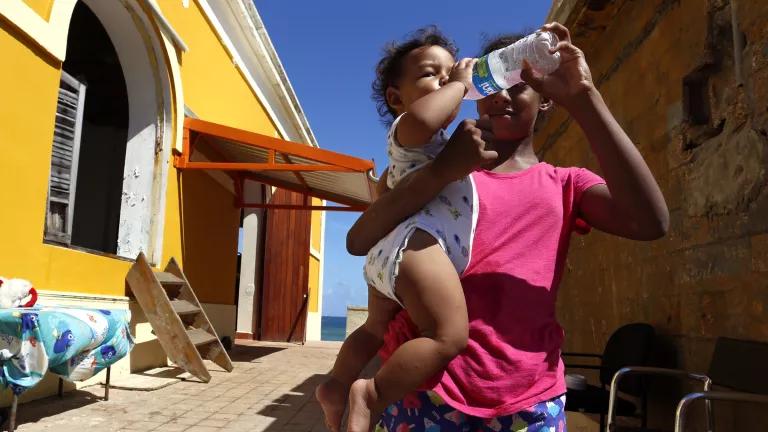New Data: 2 Million Puerto Ricans Risk Water Contamination
Government data obtained by NRDC confirmed that several Puerto Rico cities are at risk of bacterial contamination in their water supply.

Children in the neighborhood of Le Perla, San Juan after Hurricane Maria
Thais Llorca/EFE/Newscom
Over two-thirds of the population of Puerto Rico was at potential risk of exposure to bacterial contamination in the aftermath of Hurricane Maria, according to government test results obtained by NRDC. More than 2.3 million Puerto Rican residents were served by water systems which drew at least one sample testing positive for total coliforms or E. coli after Maria devastated the island in September.
Bacterial testing was recently conducted by the Puerto Rico Department of Health in response to the hurricanes, according to the Environmental Protection Agency. NRDC obtained the results for coliform bacteria and E. coli from government sources, but has not received test results for other contaminants. NRDC also requested test results from the Puerto Rico Aqueduct and Sewer Authority, the largest drinking water provider on the island, but did not receive a response.
The government of Puerto Rico noted in its request for disaster recovery assistance that over 70 percent of the island’s water treatment and distribution systems were affected by Hurricane Maria.
The tests performed by the Puerto Rico Department of Health confirmed that several cities in Puerto Rico are at risk of bacterial contamination in their water supply, in the aftermath of Hurricane Maria. The documents show that forty-two cities had a water sample testing positive for total coliforms—an indicator of potential pathogen contamination in the water. One of those cities is San Juan, whose water system serves upwards of one million residents. Five cities had a sample testing positive for E. coli—an indicator of potential fecal contamination in the water. Many cities drew samples that subsequently tested negative for both bacterial indicators; several cities fluctuated between drawing positive and negative samples. (One limitation of the data is that a single test finding coliform or E. coli contamination at one site in a water system is an indicator of a potential problem in one area, but does not necessarily mean that everyone served by that system is at risk; sometimes part of a distribution system can be contaminated while other parts are safe.) The tests were conducted through October and November 2017.
Coliforms are a family of bacteria common in soils, plants, and animal intestines. The presence of coliform bacteria indicates that disinfection may not be working properly, and that disease-causing organisms may be present in the water. A finding of total coliform does not necessarily demonstrate pathogen contamination, however. And a positive total coliform or E. coli sample does not always constitute a violation of the Total Coliform Rule, under the Safe Drinking Water Act. But there are media and independent health care provider reports of potentially widespread waterborne microbial illnesses on the island, which may be linked to bacterial contamination in drinking water.
The data NRDC has obtained suggest that several of Puerto Rico’s water distribution systems may have been compromised by the hurricane. Puerto Rican residents are under a 'boil water advisory,' but many are struggling without power, or with frequent power loss. More than two months after Maria’s landing in Puerto Rico, boiling water remains challenging, and in some cases, impossible for residents on the island.
Decades of disinvestment in Puerto Rico’s drinking water infrastructure has left the island uniquely vulnerable to contamination following extreme weather events, like Maria. Even before Maria hit, Puerto Rico had the worst water in the nation, with 99.5 percent of Puerto Ricans—virtually the entire island—served by water systems in violation of the Safe Drinking Water Act. (A report by NRDC and our community partners on Puerto Rico drinking water explains more.) These violations included contamination with bacteria or chemicals, failure to properly treat the water, and failure to conduct water testing or to report as required by federal rules.
Whenever a water system loses pressure after an extreme weather event, like a hurricane, there’s an increased risk that bacterial contamination may be drawn into the distribution system. In leaky and aging water systems like Puerto Rico’s, that risk is exacerbated.
The latest testing data confirms the critical need for substantial investment in drinking water infrastructure in Puerto Rico, to fix the island’s broken water systems. With the health of the island’s inhabitants at stake, Congress must act now to prevent future water crises on the island.
The Environmental Protection Agency and the Puerto Rico Department of Health should also conduct more comprehensive testing, and determine whether incidences of bacterial illnesses on the island are linked to drinking water contamination.
A separate post shows all water systems which have had a water sample test positive for total coliforms or E. coli (Escherichia coli) after Hurricane Maria.
This blog provides general information, not legal advice. If you need legal help, please consult a lawyer in your state.


